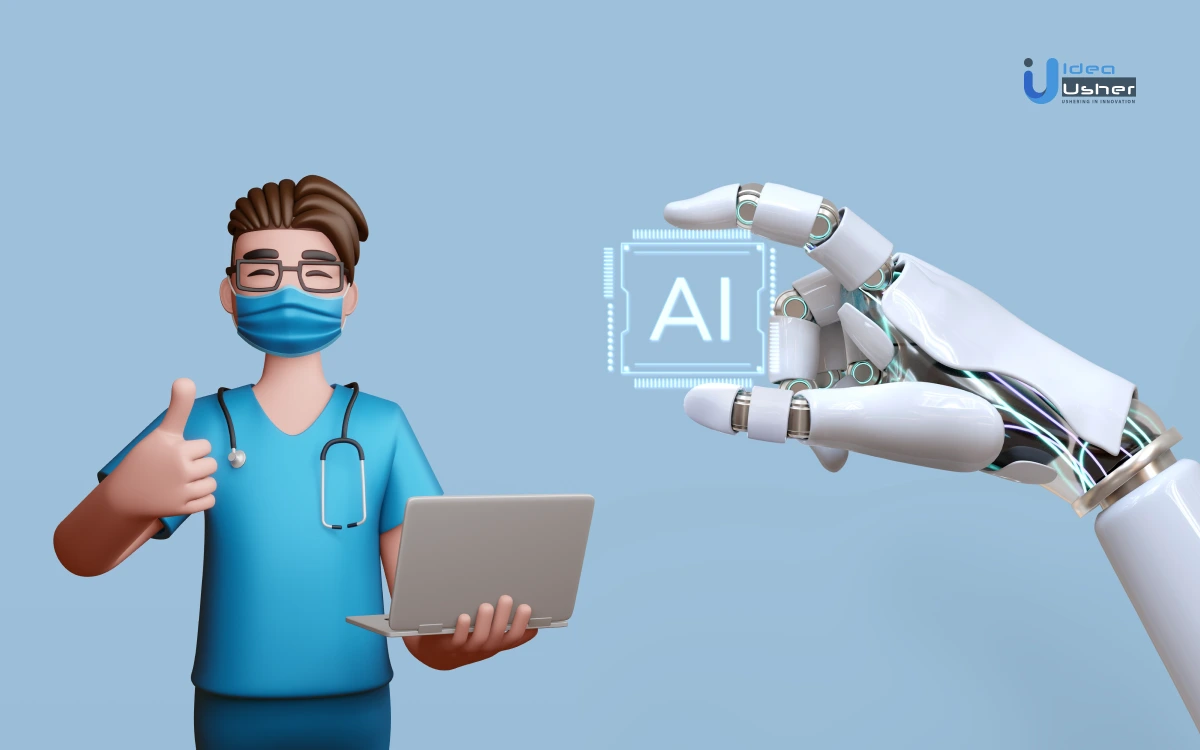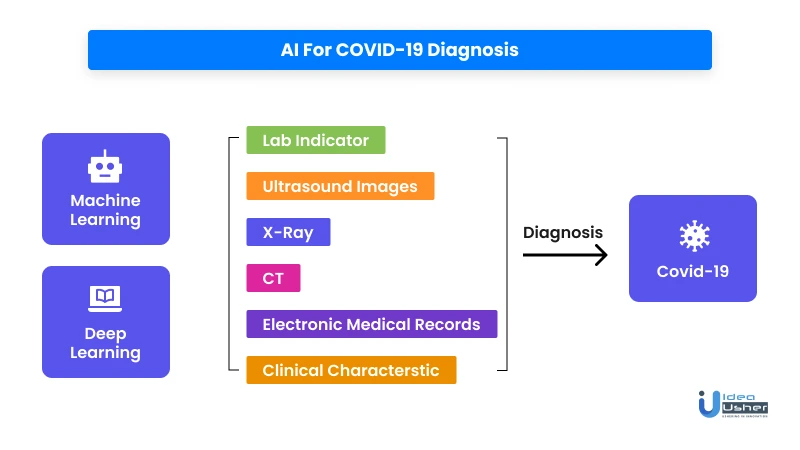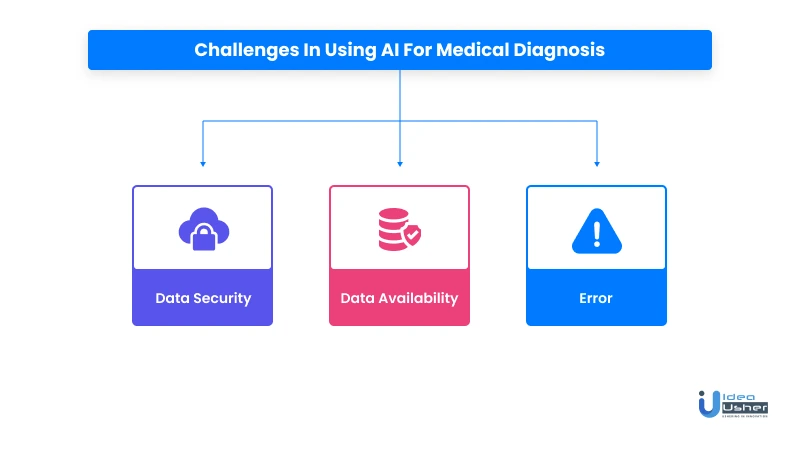
Did you know? In the U.S., over 12 million adults seeking outpatient medical care receive a misdiagnosis each year, according to BMJ Quality and Safety. How can this number be reduced? By employing AI for medical diagnosis.
Yes, you read that right! Artificial intelligence (AI) is one of the most disruptive technologies of the last decade. Why do we say so? Because it has been rapidly impacting almost every industry, be it finance, retail, education, or healthcare. Healthcare has seen a massive transformation ever since newer technologies like blockchain, AI, and IoT came up. AI for medical diagnosis not only helps in correctly diagnosing disease but also helps improve the healthcare infrastructure.
But what are some use cases of AI in medical diagnosis? How will it help the healthcare industry? What are the possible challenges? We’ll answer these questions in this blog article. Let’s get started.
What are the benefits of using AI for medical diagnosis?
Many physicians worldwide face physical burnout due to long working hours, overwhelming workloads, and lack of support. They are leaving their jobs, struggling to provide quality care, and facing emotional challenges. Technological integration can significantly improve this situation and ease the burden on medical professionals.
Here’s how AI can help in medical diagnosis:
1. Symptom analysis
Many health professionals globally are using AI to detect symptoms of various diseases accurately. The AI system analyzes the symptoms by asking several questions to the patients and then suggests the appropriate remedy for their condition. This system can be integrated into mobile applications, wearables, or standalone AI devices depending on the use case and feasibility.
For example, Symptoma is an AI symptom checker and digital health assistant with a more than 95% accuracy rate for over 20,000 diseases. Its database contains billions of links to symptoms and gives medical practitioners fast access to trustworthy (usually dispersed) expert information to build diagnoses.
Moreover, AI and deep learning algorithms can analyze large data volumes, such as a patient’s cellular analysis, genetics, and lifestyle, to form conclusions helping doctors choose precise therapies.
2. Disease Detection
Disease detection is yet another significant application of AI in healthcare. AI deep learning medical tools help medical professionals accurately detect diseases using radiological information.
For example, AI is very crucial in detecting COVID-19 disease among patients. It mainly consists of two aspects: machine learning and deep learning, and AI devices and applications diagnose the condition using electronic medical records and medical images, such as CT, X-ray, ultrasound images, etc.

Further, professionals can use AI in clinical trials to significantly reduce diagnostic errors and improve disease detection efficiency. A recent study published in the journal of the National Cancer Institute shows that an AI system can detect breast cancer as effectively as a typical breast radiologist, with a 95% accuracy rate.
3. Health monitoring with wearables and other devices
Today, almost everyone has access to personal health devices and trackers fitted with sensors that provide crucial health information. Connecting these wearable devices with smartphones has enabled individuals to track their health and assess issues on the go.
Further, analyzing and interpreting this data, and information that people provide through apps and other personal diagnostic equipment, can provide a unique perspective on individual and community health. In medicine, artificial intelligence will be important in extracting relevant insights from this huge and diverse data collection.
4. AI in dermatology
In the past few years, AI has contributed significantly to the field of dermatology; skin cancer, eczema, and psoriasis are some areas where AI has been helpful.
| Skin cancer | Researchers have been investigating the use of AI to enhance or complement current screening techniques in melanoma and nonmelanoma skin cancer (NMSC). AI is also used to distinguish between benign and malignant lesions. |
| Ulcer assessment | Currently, AI is mainly used to assess diabetic and pressure ulcers. AI applications can measure accurate wound boundaries and distinguish between the types of tissue involved. |
| Psoriasis | AI is concerned chiefly with enhancing psoriasis classification algorithms through image recognition. It can aid in clinical assessment, the selection of tailored therapy regimes, and outcome prediction. |
| Atopic dermatitis | Some artificial neural networks help to differentiate between atopic dermatitis and unaffected skin using information received from images. |
| Onychomycosis | Deep learning AI increases the diagnostic accuracy for onychomycosis with a reference set comprising all possible images. |
5. AI in ophthalmology
Artificial intelligence in ophthalmology focuses mostly on disorders with a high occurrence, such as diabetic retinopathy (DR), age-related macular degeneration, glaucoma, retinopathy of prematurity, age-related or congenital cataract, and a few with retinal vein occlusion.
DR is the most significant cause of blindness in working-age persons, primarily affecting the retinal microvasculature and causing gradual damage. As more people get afflicted, DR is being recognized as a global public health issue. The automatic diagnosis of DR has sparked a lot of interest, with studies detecting microaneurysms, hemorrhage, exudation, cotton-wool spots, and neovascularization, as well as further classifying phases.
The majority of them use fundus photos as input. The computers receive many photos annotated with diagnostic lesions, extract their properties, and then construct a model. Then it can detect the new input photos and make a decision. Some use feedforward neural networks to classify stages, while others use convolutional neural networks (CNN).
6. Risk prediction
AI can also forecast individual and community health risks to help improve overall patient experiences. Doctors at the University of Pennsylvania developed a machine learning system in the medical field that can track hundreds of crucial features in real-time to detect sepsis or septic shock in patients 12 hours before symptoms emerge.
Because early disease signals are frequently visible in laboratory test results, AI prediction models could help detect areas of risk before significant physical symptoms develop. By incorporating AI into the laboratory data workflow, routine test results might be linked with other relevant patient information like age, gender, and so on for use in disease-specific predictive models. By combining this data, labs can develop disease-specific patient likelihood scores that might alert clinicians to areas of concern and potential patient risk or diagnosis.
7. Improved paperwork
Besides detecting symptoms and diseases, AI in healthcare and medical diagnosis is also helpful in accelerating the paperwork. AI-enabled speech recognition technologies integrated in web-based or mobile applications help doctors dictate notes and fill forms verbally, thus eliminating the unnecessary time spent typing or writing. By automating form filling, AI can accelerate critical activities and detect errors before they become uncontrollable.
AI can also boost human specialists’ efficiency by speeding up scan reading and automating data entry. By taking such time-consuming activities off their plates, AI helps healthcare personnel to spend more time connecting with patients.
8. Improved clinical decision making
A physician has many tasks to perform in a day, including diagnosing diseases, developing treatment plans, documenting activities, etc. It can overwhelm many clinicians to research, diagnose, and seek solutions to problems. However, AI integration can significantly ease the process by simplifying difficult, time-consuming, and laborious tasks while providing personalized solutions to patients. Doctors can look for digital solutions such as AI-powered websites, software, or applications to speed up their decision-making process.
What are some of the possible challenges in using AI for medical diagnosis?
While AI provides significant advantages in improving and enhancing medical diagnosis and other healthcare processes, it also poses some challenges. However, we can overcome these challenges with AI advancements and better technology adoption.

The challenges are discussed below:
1. Data security
The desire for large datasets motivates developers to collect such data from many patients. Some patients may be concerned that this data collection would violate their privacy, and data sharing between large health institutions and AI companies have also resulted in lawsuits.
2. Data availability
Data from many sources, including electronic health records (EHRs), pharmaceutical records, symptom data, and consumer-generated information such as activity trackers or purchase histories, are required to train AI systems. Health information, however, is frequently problematic, and data is usually dispersed across multiple platforms.
Aside from the differences mentioned above, patients frequently switch doctors and insurance providers, resulting in data fragmentation across many systems and formats. This fragmentation increases the risk of inaccuracy, reduces dataset comprehensiveness, and raises data acquisition costs, thus limiting the types of businesses that can build successful healthcare AI.
3. Error
There is always some risk of error involved while using any technology, including AI. Occasionally, AI systems can be erroneous, which could significantly influence the patient’s life or other healthcare issues. If an AI system delivers a patient the wrong prescription, fails to detect a tumor on a radiological test, or assigns a hospital bed to one patient over another because it incorrectly anticipated which patient would benefit more, the patient may suffer harm. Despite this, many injuries result from medical errors in the current healthcare system, even when AI is not involved.
Some research conducted to test AI for medical diagnosis
Alzheimer’s diagnosis
Alzheimer’s is a disease that worsens dementia symptoms with time. It causes memory loss in the early stages, but eventually, it loses the ability to conduct conservation and respond to the surroundings. Several groups tried to diagnose this disease using AI and were quite successful.
- Soundarya et al. provided a methodology for the ancient study of Alzheimer’s disease that uses a description of shrinking brain tissue. They used a variety of machine and deep learning algorithms. Additionally, the deep algorithm has been deemed the best solution provider for detecting the disease at its early stages with fair accuracy.
- Subasi provided a broad framework for AI algorithms to diagnose Alzheimer’s disease. The learning process is the optimization of model parameters using a training dataset or prior experience. Learning models can be predictive, that is, they can anticipate the future, and descriptive, that is, they can collect data from input data sources and combine them. In machine learning and deep learning, two essential processes are performed: pre-processing the massive input and improving the model. The second part entails successfully testing the learning model and resembling the solution.
Cancer diagnosis
AI techniques can impact various aspects of cancer therapy, including drug discovery, development, and clinical validation.
- Pradhan et al. investigated many machine learning methods adaptable for lung cancer detection and linked to the internet of things. They looked at several articles that used a machine learning algorithm to predict various diseases. They also selected and depicted different study directions based on the existing approaches.
- Memon et al. suggested an AI calculation-based symptomatic framework that effectively categorized the hazardous and beneficial persons in the internet of things environment. The proposed technique was tested on the Wisconsin Diagnostic Breast Cancer. They demonstrated that the recursive element determination computation selected the best subset of highlights, and the classifier support vector machine achieved 99% order precision, 98% affectability, and 99% Matthew’s coefficient.
Tuberculosis diagnosis
AI is proposed as a possible aid in the fight against tuberculosis. Indicative radiography computer-based reasoning applications may provide exact ways of detecting infections in low-income countries.
- Romero et al. used classification tree analysis to uncover correlations between TB predictors in England. They used Sam Tuberculosis management to work on American Public Health Association data from demographic herd features to tuberculosis factors. First, they employed a machine-learning algorithm, then performed data preparation, reduction, and analysis to obtain the results.
- Sathitratanacheewin et al. created a convolution neural network model based on TB. They employed a specific chest X-ray dataset from the national library of medical Shenzhen no. 3 hospitals, and tested it with a non-tuberculosis chest X-ray dataset from the National Institute of Health Care and Center. Further, the deep convolutional neural network model acquired a region of curve area under the curve of 0.9845 and 0.8502 for identifying tuberculosis, with a specificity of 82% and a sensitivity of 72%.
What is the future of AI in medical diagnosis?
AI in medical diagnostics market size will be worth $9.38 billion by 2029.
Meticulous Research
The main factors driving the growth of AI in medical diagnosis are:
- High rate of errors in medical diagnosis
- Shortage of healthcare professionals
- Increasing prevalence of chronic diseases
Because of its several advantages, AI will likely reduce patient wait times and improve future hospital and healthcare system efficiency. As this technology advances, more and more healthcare institutions are adopting AI-powered devices and applications to improve their processes and functions.
If you’re in the healthcare industry and have already digitized your business, you can look for ways to integrate AI into your existing digital infrastructure. Otherwise, if you haven’t yet stepped into the digital world, you can develop your website or mobile application with AI capabilities to enhance your efficiency and speed up your processes. But AI integration is a complex process, and it would be best if you connected with a technology company having expertise and experience in the domain.
Idea Usher is a leading technology company providing top-quality AI-related services to clients worldwide. Our experts have years of experience and in-depth knowledge of various AI aspects, such as machine learning and deep learning.
Contact us to take your healthcare startup a notch higher with our AI solutions.
E-mail: [email protected]
Phone Numbers : (+91) 946 340 7140, (+91) 859 140 7140 and (+1) 732 962 4560
Frequently asked questions
Here are some exciting FAQs about AI for medical diagnosis:
1. Can AI diagnose better than doctors?
AI has taken great strides in improving the healthcare infrastructure by providing a more accurate and faster diagnosis. In most cases, the AI diagnosis is better than those that doctors perform. However, due to its inherent limitations, we cannot rely entirely on AI for diagnosis, and it can only assist in improving the existing functions.
2. Is AI going to replace doctors?
AI helps to enhance the diagnosis process by improving accuracy and reducing time. However, like any other technology, it has some limitations; thus, human intervention is sometimes required.
3. What diseases can AI detect?
AI can detect several diseases, such as cancer, heart diseases, Alzheimer’s, skin diseases, diabetic retinopathy, etc.









Nikhil Jassal